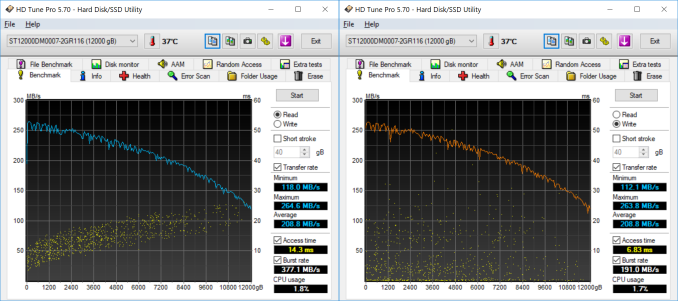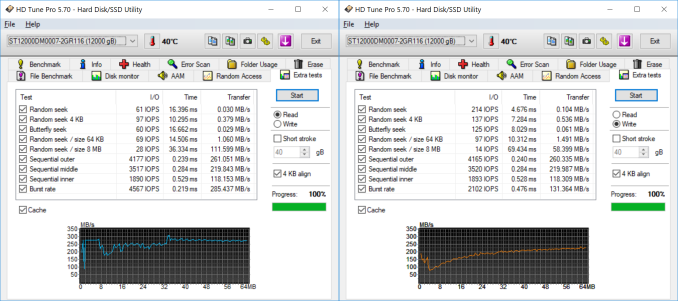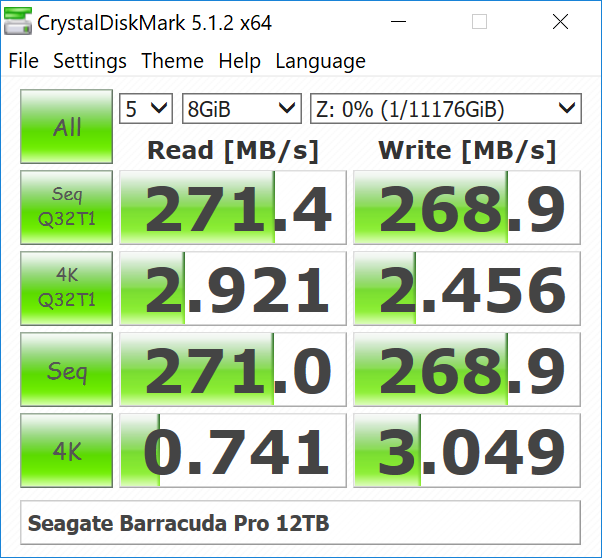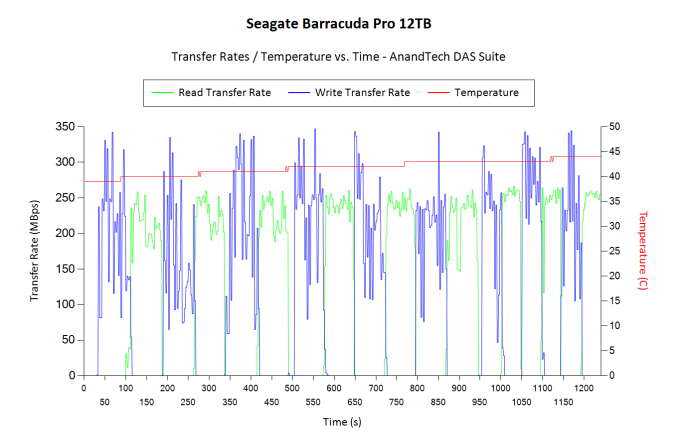Seagate BarraCuda Pro 12TB HDD Review
by Ganesh T S on November 15, 2017 8:00 AM EST- Posted in
- Storage
- Seagate
- HDDs
- Helium HDD
Performance - Internal Storage Mode
The performance of an internal storage device is dependent on the performance characteristics of the device as well as the file system being used. In order to isolate the effects of the latter, we first benchmarked the raw drives using HD Tune Pro 5.70. It was then formatted in NTFS and subject to our standard direct-attached benchmark suite.
Raw Drive Performance
HD Tune Pro allows us to run a variety of tests to determine transfer rates and IOPS for various artificial workloads. In addition, it also allows us to visualize how the performance varies as the tracking head moves from the outer parts of the platter towards the center (i.e, transfer rates as a function of the block address).
Empty drives are bound to perform very well, but, depending on the location of the data in the drive, we find that access rates can go as low as 112 MBps for sequential workloads. Write access times are a bit unpredictable due to the multi-segmented cache.
Random accesses are never the strong points of hard drives, and we see that the BarraCuda Pro delivers around 70 IOPS for 4K random reads and writes.
The extra tests help in putting some numbers to sequential accesses targeting different areas of the drive. It also provides some interesting numbers relevant to various random access workloads.
DAS Benchmarks
Consumers opting for drives such as the 12TB Seagate BarraCuda Pro typically need high-capacity local storage for holding and editing / processing large-sized multimedia files. Prior to taking a look at the real-life benchmarks, we first check what CrystalDiskMark has to report for the drive.
In order to tackle the real-life use-case of transferring large amounts of data back and forth from the drive, we created three test folders with the following characteristics:
- Photos: 15.6 GB collection of 4320 photos (RAW as well as JPEGs) in 61 sub-folders
- Videos: 16.1 GB collection of 244 videos (MP4 as well as MOVs) in 6 sub-folders
- BR: 10.7 GB Blu-ray folder structure of the IDT Benchmark Blu-ray (the same that we use in our robocopy tests for NAS systems)
| Seagate BarraCuda Pro 12TB robocopy Benchmarks (MBps) | ||
| Write Bandwidth | Read Bandwidth | |
| Photos | 219.23 | 205.51 |
| Videos | 231.42 | 219.46 |
| Blu-ray Folder | 234.05 | 230.02 |
These numbers are consistently around 15 - 20 MBps more than what we obtained for the 10TB drives last year.
While processing our DAS suite, we also recorded the instantaneous transfer rates and temperature of the drive. Compared to typical disk drives, the write transfers show higher instantaneous speeds due to a combination of the firmware and the 256 MB cache inside the drive. However, sustained write rates are comparable to other high-capacity drives when the cache is exhausted. The temperature of the unit at the end of the transfers (more than 250GB of traffic) rose by less than 5C, pointing to the power-efficiency of the platform.
For the use-case involving editing of multimedia files directly off the disk, we take advantage of PCMark 8's storage benchmark. The storage workload is a good example of a user workload, involving games as well as multimedia editing applications. The command line version allows us to cherry-pick storage traces to run on a target drive. We chose the following traces.
- Adobe Photoshop (Light)
- Adobe Photoshop (Heavy)
- Adobe After Effects
- Adobe Illustrator
Usually, PCMark 8 reports time to complete the trace, but the detailed log report has the read and write bandwidth figures which we present in our performance graphs. Note that the bandwidth number reported in the results don't involve idle time compression. Results might appear low, but that is part of the workload characteristic.
| Seagate BarraCuda Pro 12TB PCMark8 Storage Benchmarks (MBps) | ||
| Write Bandwidth | Read Bandwidth | |
| Adobe Photoshop (Light) | 250.22 | 9.06 |
| Adobe Photoshop (Heavy) | 246.88 | 11.48 |
| Adobe After Effects | 89.74 | 8.85 |
| Adobe Illustrator | 196.38 | 8.42 |
Compared to the results from the 10TB drive last year, we find that the read workloads are slightly worse off, but, the write workloads are much faster.















62 Comments
View All Comments
jabber - Thursday, November 16, 2017 - link
I would also say only fools tie themselves down with multi TB amounts of personal data. Data is a millstone round your neck.bigboxes - Friday, November 17, 2017 - link
RAID was not invented to protect your data. It's for uptime. You can live without RAID. Backup is essential for anything you value. RAID is not backup.piroroadkill - Wednesday, November 15, 2017 - link
I find it amusing that people are STILL saying this. When drives hit 500GB, 1TB, you name it, the same comment. Over, and over.You have a backup. Always have a backup.
blackcrayon - Thursday, November 16, 2017 - link
Exactly. Just double the price of every one of these drives in your head. You need two for backup.jordanclock - Wednesday, November 15, 2017 - link
Then don't buy just one. Or have a backup pool of 12+TB.This isn't even a valid talking point. It's just a contrarian interjection.
wumpus - Thursday, November 16, 2017 - link
Which is the whole problem of a 12TB drive with a low TB/$ value. Buy arrays of 3TB drives when you need that type of storage. It isn't a notebook drive, there is no reason to limit the number of drives you are using.Obviously once the number of drives get unwieldy, you will look into 12TB drives. But you will also be looking into tape at those sizes.
Beaver M. - Sunday, November 19, 2017 - link
At least for a NAS you will have to buy a 4+ bay one, which is so expensive that you will pay pretty much the same as for just a 2-bay system and 2 12 TB ones but wont have higher chance of failure.GreenReaper - Sunday, September 2, 2018 - link
If you really just need four bays, grab a HP MicroServer Gen 8. (I wouldn't recommend the Gen 10.)It's an actual miniature server (with iLO!), not just a NAS - but you can turn it into a NAS if you like.
zanon - Wednesday, November 15, 2017 - link
Seriously, since when has mere data size had much if any relation to data value? All of our business (and my personal) financial, tax and investment data is under 10 gigs for example, but losing it would be far worse then a terabyte of data that could (albeit with a lot of time cost) be regenerated. Of course, even that time cost would translate to a lot of lost money and pain, which is why we have backups and also redundancy (since in general it's preferable to not even suffer any downtime).The only major effect of larger drives when it comes to data is that of course they take longer to resilver (this one might be 10-12 hours at 80% capacity), and thus depending on someone's willingness/ability/time cost to deal with downtime in case of multiple failures they may want to switch up their RAID systems to have a higher level of redundancy. That's just an economic decision though and doesn't negate the need for backups as well, preferably offsite.
wumpus - Thursday, November 16, 2017 - link
Backing up 10G should give you plenty of options, and I'd recommend a belt and suspenders approach. Probably just multiple encrypted USB sticks and online storage (make sure they don't object to you pre-encrypting the data before sending it to them, most companies like that assume that they will take unencrypted data for de-duping purposes. This data obviously shouldn't be on servers unencrypted).Just make sure you have some means (presumably SHA256 based) of verifying your USB sticks.